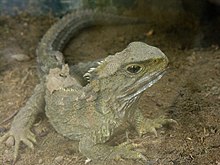টুৱাটেৰা
টুৱাটেৰা (মাওৰি, ইংৰাজী: tuatara) নিউজিলেণ্ডৰ এবিধ নিজা-থলুৱা সৰীসৃপ। জেঠীজাত জীৱৰ দৰে দেখিলেও ইহঁত বেলেগ এটা গুৰি-গোষ্ঠীৰ, যিটো হ’ল ৰাইংক’চেফালিয়া বৰ্গ।[2] ইহঁতৰ নামটো মাওৰি ভাষাৰ পৰা আহিছে যাৰ অৰ্থ "পিঠিত শৃংগ"।[3] ২০ কোটি বছৰমান আগতে উন্নতি লাভ কৰা বৰ্গটোৰ এটাই টুৱাটেৰাৰ প্ৰজাতি বাচি আছে।[4] জীৱৰ গোটেইবিলাক গোটৰ ভিতৰত ইহঁতৰ আৰু ইস্কুৱামেটৰ (সাপ আৰু জেঠীজাত জীৱৰ) একেবাৰে শেহতীয়া পূৰ্বপুৰুষ একেই।[5] এই কাৰণে জেঠীজাত জীৱৰ আৰু সাপৰ অধ্যয়নত আৰু প্ৰথম ডায়েপ্সিড (ডাইনাচৰ, য’ত চৰাইও পৰে আৰু ঘৰীয়ালজাত জীৱক সাঙুৰি লোৱা এটা এম্নিয়ট চাৰিঠেঙীয়া জীৱৰ গোট) বিলাকৰ চেহেৰা আৰু অভ্যাসৰ পুনৰনিৰ্মাণৰ বাবে টুৱাটেৰাক গুৰুত্ব দিয়া হয়।
| টুৱাটেৰা (Tuatara) জীৱাশ্ম কাল: Pleistocene – present,[1] 0.126–0Ma | |
|---|---|

| |
| মতা উত্তৰীয়া টুৱাটেৰা (Sphenodon punctatus) | |
| সংৰক্ষণ স্থিতি | |
| জীৱবৈজ্ঞানিক শ্ৰেণীবিভাজন | |
| ৰাজ্য: | Animalia |
| পৰ্ব: | ক'ৰডাটা |
| শ্ৰেণী: | সৰীসৃপ |
| বৰ্গ: | Rhynchocephalia |
| পৰিয়াল: | Sphenodontidae |
| গণ: | Sphenodon John Edward Gray, 1831 |
| প্ৰজাতি | |
| |

| |
| থলুৱা বিস্তাৰ (নিউজিলেণ্ড) | |
টুৱাটেৰাৰ বৰণ সেউজীয়াৰ দৰে মটীয়া আৰু ধোঁৱাবুলীয়া, ইয়াৰ দীঘ মূৰৰ পৰা নেজলৈকে ৮০ ছে.মি. (৩১ ইঞ্চি) আৰু ওজন ১.৩ কেজি।[6] ইহঁতৰ কাঁইটীয়া জঁ থাকে, বিশেষকৈ মতাবিলাকত বেছিকৈ দেখি। ইহঁতৰ ওপৰৰ পাৰিটোত দুশাৰীকৈ দাঁত থাকে আৰু তলৰ পাৰিটোত ওপৰৰ পাৰিৰ মাজেৰে এশাৰী দাঁত থাকে, এনেকুৱা আন কোনো জীয়াই থকা জীৱত নেদেখি। আচহুৱাকৈ ইহঁতৰ দেখা যোৱা ফটোৰিচেপ্টিভ তৃতীয় চকুও থাকে যিটোৱে চিৰ্কাডিয়ান আৰু ঋতুগত চক্ৰবোৰ কৰায় বোলে ভবা গৈছে। বাহিৰা কান নাই যদিও ইহঁতে শুনিব পাৰে আৰু ইহঁতৰ লাওখোলাত কিছুমান ইউনিক ঠাচ থাকে যাৰ কিছুমান বিৱৰ্তনগতভাবে মাছ অৱস্থাৰ পৰা বজাই ৰাখিছে যেন দেখা গৈছে। যদিও টুৱাটেৰাক কেতিয়াবা "জীৱন্ত জীৱাশ্ম" বুলি কোৱা হয়, শেহতীয়া দেহতাত্ত্বিক অধ্যয়নে ইহঁত মেছ’জৈক যুগৰ পৰা বহুত সলনি হোৱা বুলি দেখুৱাইছে।[7][8][9] ইয়াৰ জননকোষ মেপ কৰি থাকোঁতে গৱেষকসকলে এই প্ৰজাতিটোৰ খাৰযোৰৰ সংখ্যা ৫ৰ পৰা ৬শ কোটিটা আছে মানুহটোক দুগুণ।[10]
The tuatara Sphenodon punctatus has been protected by law since 1895.[11][12] A second species, S. guntheri, was recognised in 1989,[6] but since 2009 it has been reclassified as a subspecies.[13][14] Tuatara, like many of New Zealand's native animals, are threatened by habitat loss and introduced predators, such as the Polynesian rat (Rattus exulans). Tuatara were extinct on the mainland, with the remaining populations confined to 32 offshore islands[4] until the first mainland release into the heavily fenced and monitored Karori Sanctuary in 2005.[15]
During routine maintenance work at Karori Sanctuary in late 2008, a tuatara nest was uncovered,[16] with a hatchling found the following autumn.[17] This is thought to be the first case of tuatara successfully breeding in the wild on the New Zealand mainland in over 200 years.
তথ্যসূত্ৰ
সম্পাদনা কৰক- ↑ "Sphenodon". The Paleobiology Database. Archived from the original on 20 June 2018. https://web.archive.org/web/20180620110712/http://fossilworks.org/?page=paleodb। আহৰণ কৰা হৈছে: 7 June 2014.
- ↑ "Tuatara". New Zealand Ecology: Living Fossils. TerraNature Trust. 2004. http://www.terranature.org/tuatara.htm। আহৰণ কৰা হৈছে: 10 November 2006.
- ↑ "The Tuatara". Kiwi Conservation Club: Fact Sheets. Royal Forest and Bird Protection Society of New Zealand Inc.. 2009. Archived from the original on 16 October 2015. https://web.archive.org/web/20151016044037/http://www.kcc.org.nz/tuatara। আহৰণ কৰা হৈছে: 13 September 2017.
- ↑ 4.0 4.1 "Tuatara". Conservation: Native Species. Threatened Species Unit, Department of Conservation, Government of New Zealand. http://www.doc.govt.nz/conservation/native-animals/reptiles-and-frogs/tuatara/। আহৰণ কৰা হৈছে: 3 February 2013.
- ↑ Rest, Joshua S.; Ast, Jennifer C.; Austin, Christopher C.; Waddell, Peter J.; Tibbetts, Elizabeth A.; Hay, Jennifer M.; Mindell, David P. (2003-01-01). "Molecular systematics of primary reptilian lineages and the tuatara mitochondrial genome". Molecular Phylogenetics and Evolution খণ্ড 29 (2): 289–297. doi:10.1016/s1055-7903(03)00108-8. http://linkinghub.elsevier.com/retrieve/pii/S1055790303001088.
- ↑ 6.0 6.1 "Reptiles:Tuatara". Animal Bytes. Zoological Society of San Diego. 2007. http://www.sandiegozoo.org/animalbytes/t-tuatara.html। আহৰণ কৰা হৈছে: 1 June 2007.
- ↑ Jones ME (2008). "Skull shape and feeding strategy in Sphenodon and other Rhynchocephalia (Diapsida: Lepidosauria)". J Morphol খণ্ড 269 (8): 945–66. doi:10.1002/jmor.10634. PMID 18512698.
- ↑ Jones ME (2009). "Dentary tooth shape in Sphenodon and its fossil relatives (Diapsida: Lepidosauria: Rhynchocephalia)". Front Oral Biol. Frontiers of Oral Biology খণ্ড 13: 9–15. doi:10.1159/000242382. ISBN 978-3-8055-9229-1. PMID 19828962.
- ↑ "A sphenodontine (Rhynchocephalia) from the Miocene of New Zealand and palaeobiogeography of the tuatara (Sphenodon)". Proc Biol Sci খণ্ড 276 (1660): 1385–90. 2009. doi:10.1098/rspb.2008.1785. PMID 19203920.
- ↑ "Tuatara genome mapping". Odt.co.nz. http://www.odt.co.nz/campus/university-otago/236527/tuatara-genome-mapping। আহৰণ কৰা হৈছে: 10 June 2018.
- ↑ Newman 1987
- ↑ Cree, Allison; David Butler (1993) (PDF). Tuatara Recovery Plan. Threatened Species Unit, Department of Conservation, Government of New Zealand. ISBN 0-478-01462-7. http://www.doc.govt.nz/upload/documents/science-and-technical/TSRP09.pdf। আহৰণ কৰা হৈছে: 2 June 2007.
- ↑ Cree, Alison (2014). Tuatara : biology and conservation of a venerable survivor. Canterbury University Press. ISBN 9781927145449.
- ↑ Hay JM, Sarre SD, Lambert DM, Allendorf FW, Daugherty CH (2010). "Genetic diversity and taxonomy: a reassessment of species designation in tuatara (Sphenodon: Reptilia)". Conservation Genetics খণ্ড 11 (3): 1063–1081. doi:10.1007/s10592-009-9952-7. Published online: 3 July 2009.
- ↑ "Tuatara Factsheet (Sphenodon punctatus)". Sanctuary Wildlife. Karori Sanctuary Wildlife Trust. Archived from the original on 21 October 2007. https://web.archive.org/web/20071021215944/http://sanctuary.org.nz/restoration/forest/tuatara/tuatara-facts.html। আহৰণ কৰা হৈছে: 28 June 2009.
- ↑ New Zealand’s ‘living fossil’ confirmed as nesting on the mainland for the first time in 200 years!, Karori Sanctuary Trust, 31 October 2008.
- ↑ Our first baby tuatara! Archived 2023-02-24 at the Wayback Machine, Karori Sanctuary Trust, 18 March 2009.
